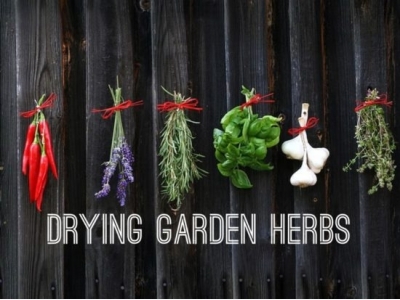How To Dry Herbs From the Garden

Drying herbs is the healthiest and most traditional way to preserve herbs for later use. There are several methods for drying herbs, but the goal is always the same. The herbs need to be dried thoroughly but retain their oil for maximum benefit and flavor.
The first step is to pick them at the right time. Harvest after the morning dew has dried, but before the heat of the sun has begun to wilt the plants. Make sure to harvest before flowering – if you've been cutting all summer, they probably haven't had a chance to flower, so harvest before the weather begins to significantly cool towards late fall.
The optimum cuts will depend on the herb in question, but most herbs are harvested by the “branch” - groupings of stems. With others, the entire plant, from root base up, is cut off. After cutting, shake them gently to drop any insects or other creepies. Then carefully go through and remove dried leaves and trim away leaves that are singed or otherwise compromised.
Remove the smaller leaves along the bottom portion of the branch and rinse in cool water. Pat dry with paper towels or cotton cloth unless you have time to let them dry on a countertop before processing.
Cut and tie string into small slip knots (lasso's) and bundle herbs into groups of 4-6 branches. The more moist the herbs, the fewer you want in each bundle. Now choose your drying method. Most common herbs can be air dried, dried in a dehydrator, etc. The more moist varieties should be done in an oven or solar dehydrator.
Drying Garden Herbs Using Air Drying
This is the most common and easiest. Put each bundle into a small paper sack with holes punched in it. Label the bag with the name of the herb, scrunch the opening of the bag around the bundle and tie it off. Then hang it from that end, so the herbs are hanging inside the bag, upside down. Keep them in a warm, airy room. Depending on temperature and humidity, your herbs will likely dry in 2-3 weeks. They should almost (but not quite) crumble at your touch when they're ready.
Drying Garden Herbs Using A Dehydrator
Put the bundles into the dehydrator and set to the lowest setting (if possible). Drying with a common dehydrator takes about 5 days or so for most herbs. If using a solar dehydrator, do not leave it in the sun during the hottest part of the day or you will cook the oils from the herbs.
Drying Garden Herbs Using An Oven
On a very low setting (200 degrees or so), place the herbs on a paper-lined cookie sheet. Leave overnight (about 8-10 hours), checking for the last two or three hours to be sure they aren't cooking. Let them stand for about half an hour or so before handling and packaging the dried herbs.
Drying Using A Microwave
This method is generally not recommended because the microwave will definitely cook the oils out of your herbs. Some of the thicker, more moist herbs may have some of that moisture removed by using the microwave before going to another drying method.
No matter which method you chose, once the herbs are dry, you can store them in a number of ways. Many put the bundles directly into zipper bags or plastic containers with air-tight lids. Small (half quart) canning jars can also work well (just screw on the lid). Storing in this manner retains more of the oils and flavor, since the leaves stay intact until crushed at the point of use.
Crushing them is also an option, of course. Just scrape the leaves from their stems with your hand and fingers. Then crush by hand or with a mortar.
Be sure to label and date your storage with the name of the herb and the date they were stored. Keep in a cool, dry, dark place. Dried herbs are generally good for about a year.
Có thể bạn quan tâm
Phần mềm

Phối trộn thức ăn chăn nuôi

Pha dung dịch thủy canh

Định mức cho tôm ăn

Phối trộn phân bón NPK

Xác định tỷ lệ tôm sống

Chuyển đổi đơn vị phân bón

Xác định công suất sục khí

Chuyển đổi đơn vị tôm

Tính diện tích nhà kính

Tính thể tích ao hồ




 How to Weed the Organic Lawn
How to Weed the Organic Lawn  How to Grow Larkspur Flowers
How to Grow Larkspur Flowers